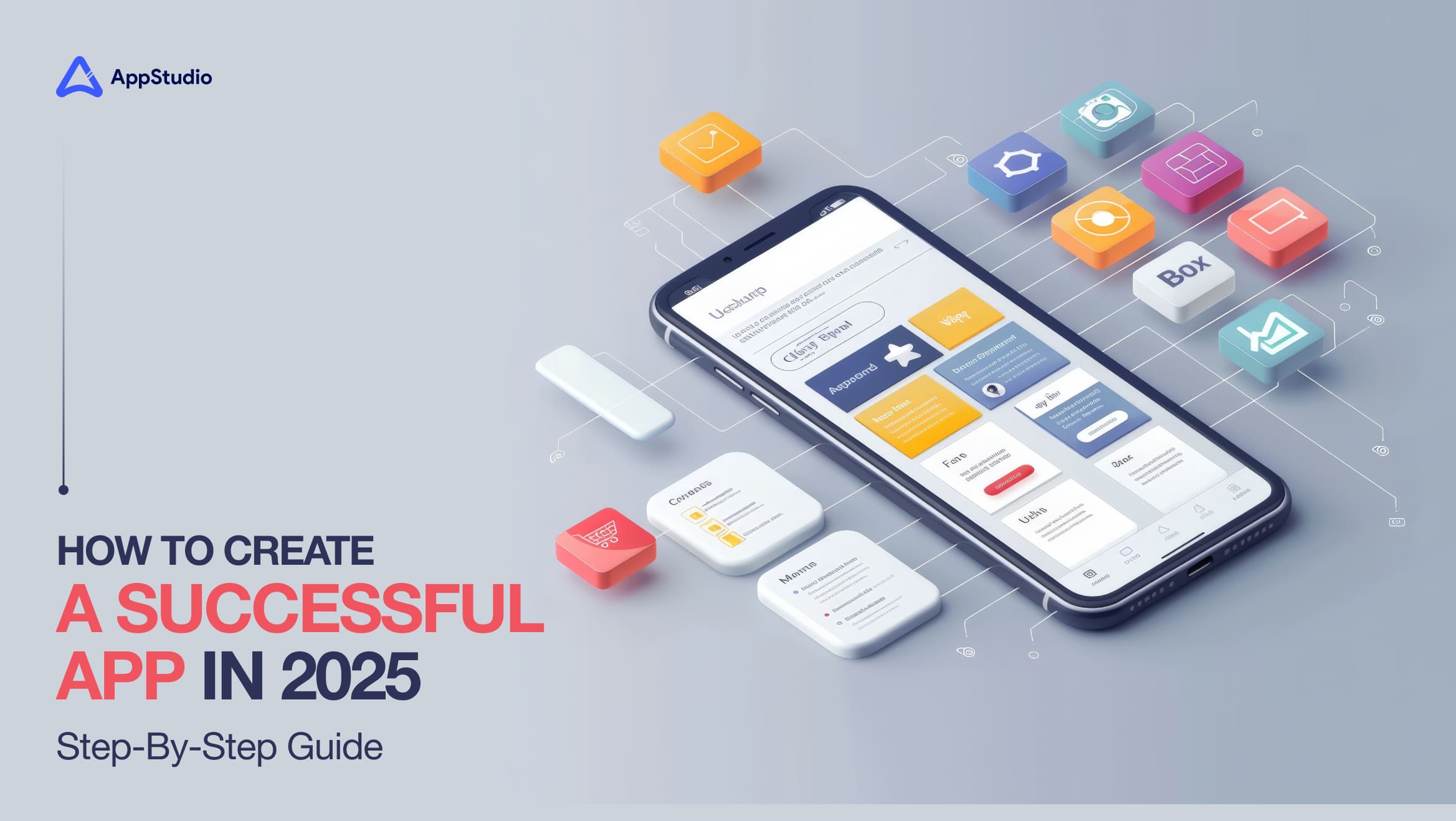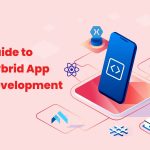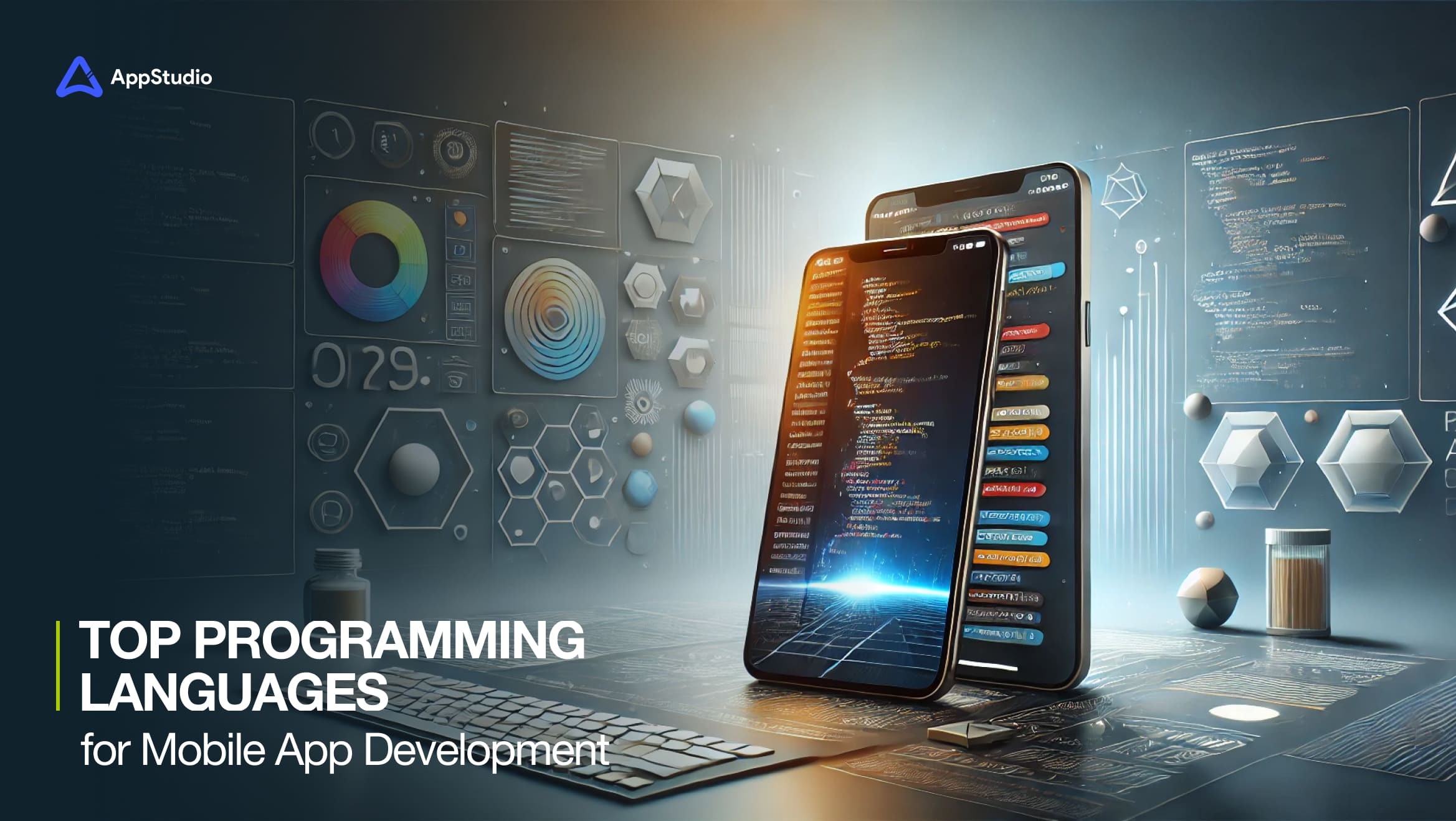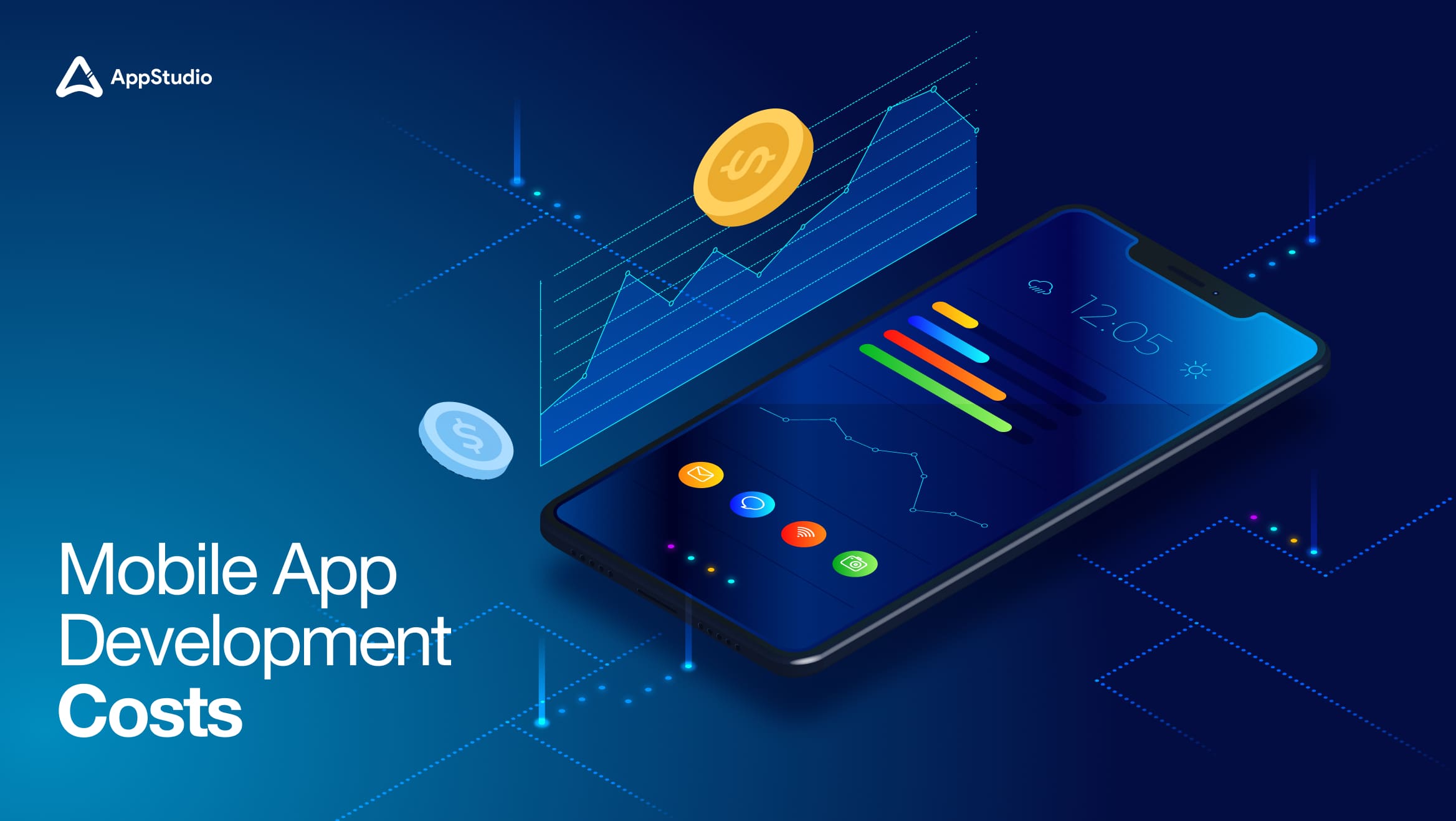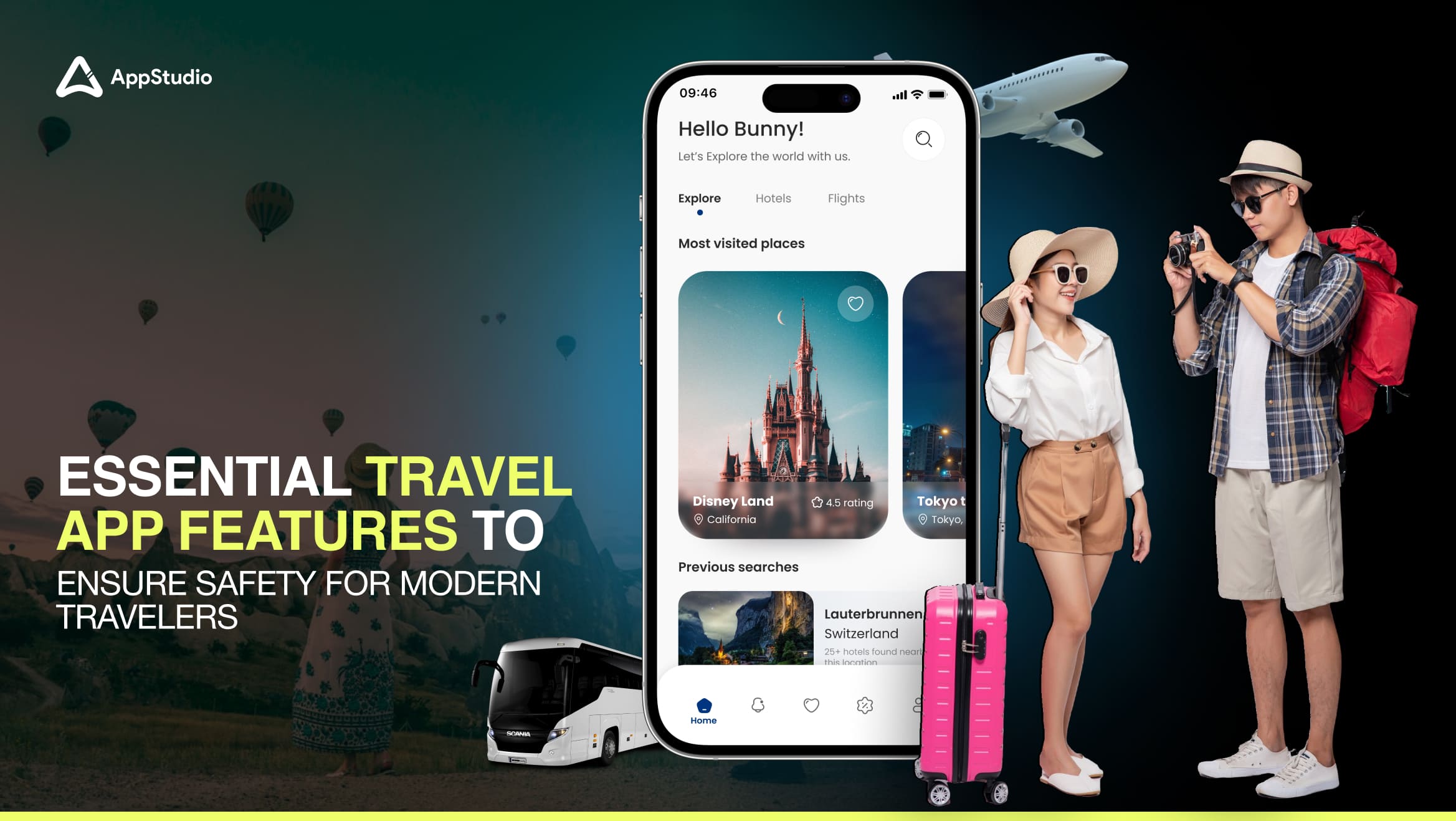In 2025, how to develop an app isn’t just an out-of-the-box question. But it sure is dreamlike. Well, why? You ask. Most people don’t know where to start, and those who do often drown in unnecessary complexity. You’ve got a brilliant idea, but every time you think about “step by step app development” process, it’s like hitting a wall of jargon, confusion, and frustration.
Here’s the kicker—successful apps aren’t born out of inspiration alone. They’re built with precision, clarity, and a step-by-step approach that gets things done. Without the right structure, you’ll waste time, burn through money, and still end up miles from where you want to be.
The solution? In this article, we’ve broken down into 14 easy and actionable stages on how to develop an app. From pre-launch planning to post-launch maintenance, this step by step app development guide will show you exactly how to bring your idea to life.
Understanding Your App Idea: What Questions to Ask
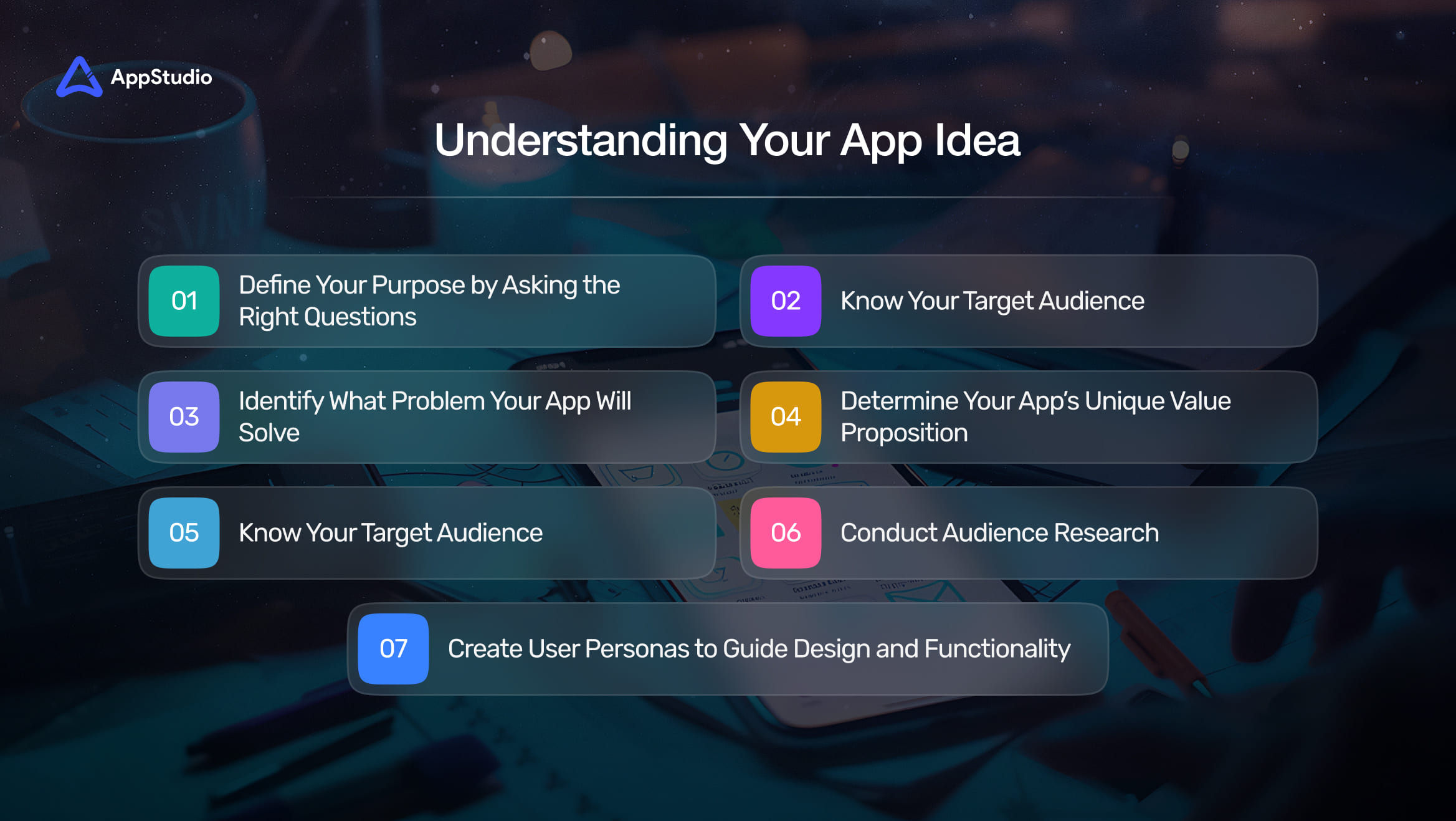
Every great app starts with a crystal-clear idea, but let’s be honest—having a vague notion about how to develop an app followed by willingly wanting to build an app won’t cut it. The steps to create an app always start with a strong foundation. Users judge your application instantly!
In less than 500 milliseconds, they’ve already made up their mind, and guess what? 94% of that comes down to the design. So it’s crucial to nail that first impression—if it’s good, users will stick around. If it’s bad, they’re gone! This underscores why steps involved in app development should always begin with clarity and focus.
If you don’t nail your purpose upfront, the rest is a house of cards waiting to collapse. Before diving deeper into the steps to develop an app, it’s time to put your idea under the microscope and ask these questions:
1. Define Your Purpose by Asking the Right Questions
If you aren’t asking the right set of questions while building the app(s), you’re missing out on the key insights needed to guide your step by step mobile app development process. These are the 5 go-to questions you must answer before starting your application development process steps in regards to :
Ques 1: What Problem Does Your App Solve?
Apps aren’t just products; they’re problem solvers. Whether it’s organizing finances, delivering faster food, or teaching a new skill, your app needs to solve one specific problem better than anyone else. This clarity ensures the success of your steps for building an app.
Ques 2: What’s Your Unique Value Proposition?
Plenty of apps already exist, so why yours? Define the unique edge your app brings to the table—whether it’s innovation, convenience, or an unmatched experience. Focusing on differentiation is critical during the steps in creating an application.
Ques 3: Who’s the Real Audience?
Spoiler alert: “Everyone” is not an audience. Hone in on your ideal users, understand their daily struggles, and figure out exactly why they’d care about your app. This is foundational to your steps of application development.
Ques 4: What Platforms Will You Target?
Are your users Android die-hards, iPhone loyalists, or both? This decision impacts your design, budget, and approach to .
Ques 5: How Will Your App Make Money?
Apps don’t pay bills on their own. Will it be ad-supported, subscription-based, or rely on in-app purchases? Deciding this upfront on the nitty-gritties of how to develop an app that saves you headaches later and helps prioritize your steps to create an app that’s not only functional but relevant is important.
Related reading: How to Plan Mobile App Development Project
2. Understand Your User Persona
If you’re building blindly, you’re building for nobody. The core of how to build an app lies in truly knowing your users and their buying persona. Here’s how you can identify them:
- Conduct Audience Research: Use surveys, analytics, or social media to uncover who your audience is. What apps do they already love? What’s missing in their experience that yours can fulfill?
- Create User Personas: Build a profile of your ideal user. What are their habits, frustrations, and priorities? By doing this, every decision—from design to functionality—will have real-world relevance.
Our Verdict: Nail these foundational steps; you’re already leagues ahead. The rest of the steps involved in app development become dramatically easier when your purpose and audience are clear.
3. Identify What Problem Your App Will Solve
Your app exists to fix a specific pain point—period! If it doesn’t, it’s noise in an already crowded market. To figure out the problem your app will solve, focus on these three areas:
- Gaps in Existing Solutions: Look at current apps in your niche. What’s missing? Maybe they’re too slow, complicated, or don’t fully address user needs. Your app should close that gap.
- Everyday Frustrations: Think about daily struggles people face that seem minor but build up over time. Can your app simplify something people hate doing or make their lives a little easier?
- Unmet Desires: Sometimes, people don’t know they need something until it’s offered. If your app delivers a “wow” moment users didn’t expect, you’ve nailed the problem-solving game.
Pro Tip: The clearer you are about the problem, the easier it’ll be to answer users asking, “Why should I download your app?”
4. Determine Your App’s Unique Value Proposition
Your unique value proposition is the heartbeat of your app—it’s the reason users will choose your app over the sea of alternatives. To nail your UVP, ask yourself:
- What Does Your App Do Better? Maybe it’s faster, simpler, or more accessible. Identify the one thing your app excels at and make it the centerpiece of your offering.
- What Makes It Stand Out? Is it a feature, design, or user experience no one else has? Your UVP could be as simple as superior usability or as advanced as cutting-edge tech integration.
- How Does It Add Real Value? Focus on outcomes. Does your app save time, reduce costs, or enhance quality of life? Frame your UVP in terms of the direct benefits to users.
Example: If you’re creating a fitness app, instead of being “just another workout tracker,” your UVP might be personalized AI-driven workout plans that adapt in real-time based on user performance.
The Goal: Make your UVP so compelling that users immediately think, “This app gets me!”
5. Know Your Target Audience
If you’re clear about how to develop an app but unclear of who your app is for, you’re building for no one.
Knowing your target audience isn’t just a step—it’s the foundation of how to build an app that resonates with users. Here’s how to figure it out:
- Research Their Needs and Preferences: Dive into your audience’s behaviors, challenges, and desires. Use surveys, focus groups, or analytics tools to uncover what they care about most.
- Understand Their Pain Points: What frustrates them daily? Whether it’s wasting time on inefficient processes or lacking access to better solutions, your app should address these struggles directly.
- Create Detailed User Personas: Build profiles of your ideal users, including their age, profession, habits, goals, and challenges. For example, if you’re creating a budgeting app, your persona might be a 30-year-old professional who wants to manage expenses without complex spreadsheets.
- Segment Your Audience: Not all users are alike. Break them into categories based on their needs—this ensures you can prioritize features for your core audience without alienating others.
- Think Long-Term Engagement: Knowing your audience means predicting how they’ll grow with your app. Build for their current needs, but keep an eye on what they might need next.
Key Takeaway: When you know your audience, you’re not guessing—you’re building something they’ll actually want to use, love, and recommend.
6. Conduct Audience Research
Audience research is where you uncover the “who” behind your app. This step isn’t just about collecting data—it’s about understanding your future users on a deep level so you can build an app that speaks to their needs and habits. Here’s how to do it effectively:
- Analyze Existing Data: Use tools like Google Analytics, social media insights, or customer surveys to identify patterns in user behavior, preferences, and demographics.
- Run Surveys and Polls: Ask potential users directly about their pain points, what they’d want in an app, and how they currently solve their problems.
- Dive into Forums and Communities: Platforms like Reddit, Quora, and niche forums are goldmines for learning what your audience cares about. Observe their questions, frustrations, and feedback on similar products.
- Study Your Competitors’ Users: Read reviews of competitor apps to identify gaps or opportunities they’ve missed. What are users praising? What are they complaining about? Use this intel to shape your approach.
- Create Focus Groups: Test your app idea with a small group of diverse users. Their feedback will offer real-world insights you can’t get from data alone.
Why It Matters: When you know your audience’s needs and behaviors, you’re not just building an app—you’re solving a real problem in a way they’ll appreciate. This is the foundation for creating an app people will love and use repeatedly.
7. Define User Characteristics to Guide Design and Functionality
Think of user personas as the blueprint for your app’s success. They’re fictional profiles that represent your ideal users, helping you design with intention. Here’s how to craft personas that truly guide your steps of application development:
- Start with Research: Pull data from audience surveys, competitor reviews, and analytics. Look for patterns—common goals, frustrations, and preferences.
- Identify Key Traits: For each persona, define their age, profession, habits, challenges, and daily routines. Are they tech-savvy or beginners? Busy professionals or casual users?
- Give Them Life: Name your personas and add personal details. For instance, “Asha, a 28-year-old graphic designer, needs an app to streamline her freelance invoicing while on the go.”
- Focus on Their Goals: What do they want to achieve using your app? Map features to these goals. For Asha, it’s a clean UI for creating invoices quickly.
- Revisit and Refine: Personas aren’t set in stone. As you test and iterate, refine them to reflect real user behavior.
User personas aren’t just about who your audience is—they’re about what they need from your app to make their lives easier, better, or more productive.
Related reading: What Are the Challenges in Mobile App Development
How to Create An App in 14 Simple Steps?
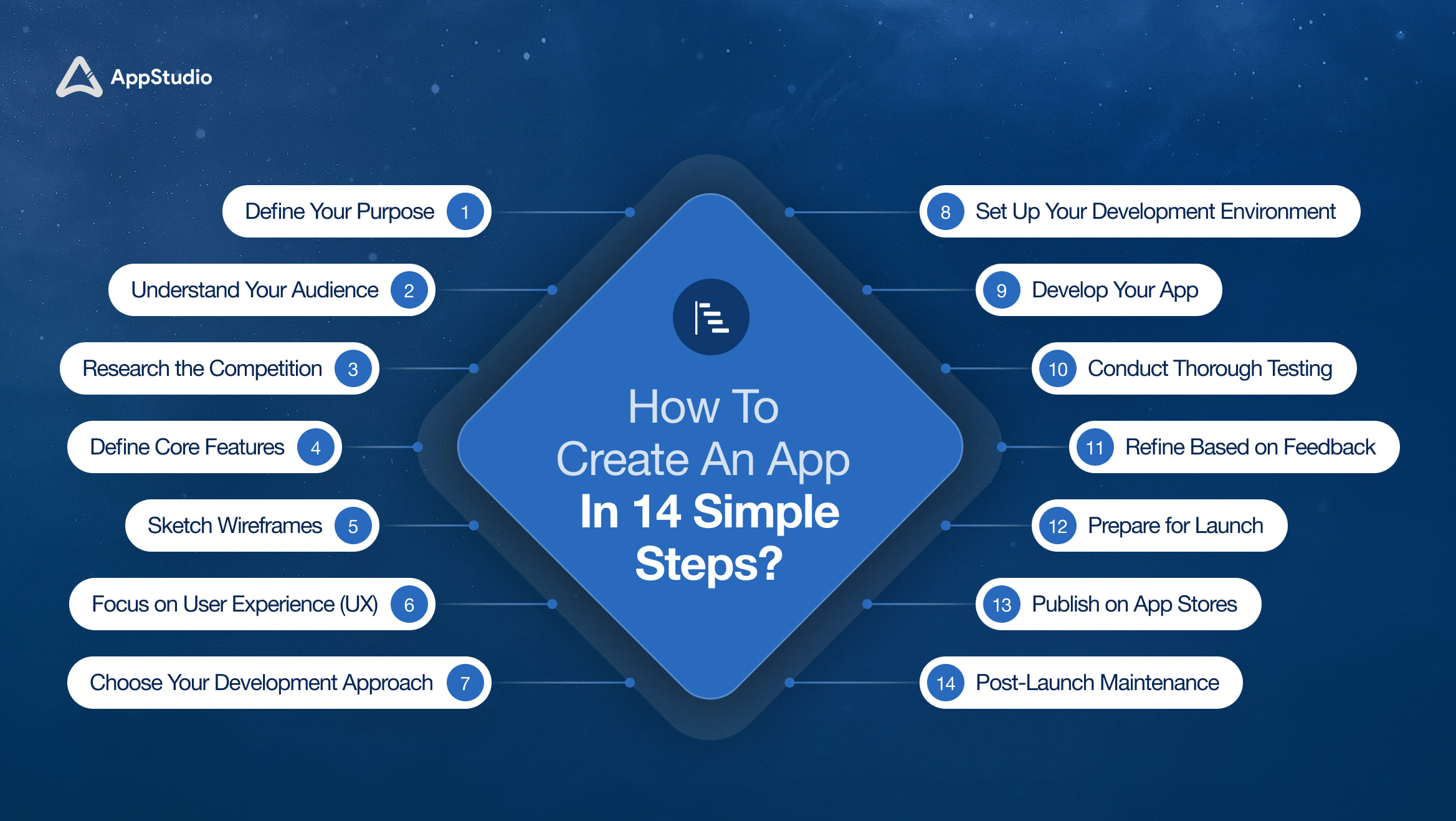
Let’s cut the fluff and get into the process. How to develop an app is not some mystical, high-tech secret anymore—it’s a structured game anyone can play if they follow the right steps. Here’s how to do it without overcomplicating anything.
1. Define Your Purpose
Before writing a single line of code, ask yourself: Why does this app exist? Your app needs a mission. Solve a problem. Simplify a process. Fill a gap that’s been bugging people forever.
Relatable Angle: Think of Uber—built because no one wanted to stand in the rain waving for a taxi.
How to Do It:
- Write down the problem you’re solving in one sentence.
- Ask, “Would I download this app if I didn’t create it?” If the answer’s no, go back to the drawing board.
This step kicks off your steps to create an app effectively by focusing on the why behind your app idea.
2. Understand Your Audience
Your app isn’t for everyone. It’s for a specific group of people. Who are they? What do they care about?
Relatable Angle: Imagine selling a gourmet vegan meal plan to a die-hard steak lover. Wrong audience, wasted effort.
How to Do It:
- Research their habits, frustrations, and desires.
- Build 2-3 personas to represent your ideal users.
Knowing your audience ensures that every step in creating an application aligns with their needs.
3. Research the Competition
Don’t reinvent the wheel—learn from others. Look at what’s working and, more importantly, what’s not.
Relatable Angle: It’s like watching a rival player’s game tape before your match. Learn their strengths and exploit their weaknesses.
How to Do It:
- Study the top apps in your niche.
- Read reviews to find common complaints and missed opportunities.
Competitor analysis helps you understand the steps involved in app development from a market perspective.
4. Define Core Features
Every app idea starts big: “It’ll do everything!” No. Start with the basics—the features that solve the core problem.
Relatable Angle: Think of Instagram at launch—just photo sharing. No DMs, no Stories, no Reels. Simplicity first.
How to Do It:
- Make two lists: must-have features and “nice-to-haves.”
- Prioritize based on what delivers the most value to users.
This step ensures you focus on the essential steps of application development first.
5. Sketch Wireframes
Wireframes are the skeleton of your app—a simple visual representation of how it’ll look and flow.
Relatable Angle: It’s like sketching a house before calling the contractor. No blueprints, no progress.
How to Do It:
- Use tools like Figma or even pencil and paper.
- Map out every screen and the transitions between them.
Wireframing is an integral part of your application development process steps.
6. Focus on User Experience (UX)
A great app isn’t just functional; it’s intuitive. Users should “get it” without a tutorial.
Relatable Angle: Imagine walking into a store where everything’s labeled clearly vs. one where nothing makes sense. Which would you prefer?
How to Do It:
- Keep navigation simple.
- Make it easy for users to complete key actions (e.g., ordering, booking, sharing).
Good UX design enhances every step in creating an application.
7. Choose Your Development Approach
Decide whether you’ll go native (iOS/Android-specific), hybrid (works everywhere), or no-code (quick and easy).
Relatable Angle: It’s like choosing between a custom-built car, an off-the-shelf model, or renting a bike. Each has its time and place.
How to Do It:
- Native: Best for performance but expensive.
- Hybrid: Decent middle ground for cost and functionality.
- No-code: Quick to build, limited customization.
This decision directly impacts the success of your step by step mobile app development plan.
8. Set Up Your Development Environment
Think of this as preparing your workspace. Without the right tools, you’re going nowhere.
Relatable Angle: It’s like trying to bake a cake without a mixer, pans, or oven. You need the essentials.
How to Do It:
- Use IDEs like Xcode (iOS) or Android Studio (Android).
- Set up Git for version control to save every change.
Having the right tools streamlines your steps to develop an app.
9. Develop Your App
This is where your app starts coming to life. The code turns ideas into actions.
Relatable Angle: Building an app is like writing a recipe—every ingredient (code) needs to go in the right order for it to work.
How to Do It:
- Start with core features.
- Test functionality after completing each section.
Development is one of the most critical steps of app development.
10. Conduct Thorough Testing
Bugs kill apps. No one likes crashes, slow load times, or broken buttons.
Relatable Angle: Imagine buying a car, and the brakes don’t work. That’s what a buggy app feels like to a user.
How to Do It:
- Run unit tests (individual features) and integration tests (features working together).
- Beta test with real users for honest feedback.
Testing is essential to the steps for building an app that users trust.
11. Refine Based on Feedback
Your first version won’t be perfect—and that’s okay. What matters is making it better based on real-world feedback.
Relatable Angle: Think of it like editing a draft. The magic happens in the rewrites.
How to Do It:
- Collect feedback via surveys or app analytics.
- Update the app and test again.
This step ensures your steps to develop an app are iterative and user-driven.
12. Prepare for Launch
A great app needs a great debut. Your launch plan is your ticket to visibility.
Relatable Angle: It’s like opening a restaurant—without advertising, even the best food will go unnoticed.
How to Do It:
- Create buzz with teasers, social media, and email campaigns.
- Optimize your app store listing with keywords and visuals.
Marketing plays a crucial role in the steps of app development.
13. Publish on App Stores
Submitting your app isn’t just hitting “upload.” Each platform has rules. Follow them.
Relatable Angle: It’s like applying for a visa—one wrong document, and you’re out.
How to Do It:
- Use Google Play Console or Apple Developer Program for submission.
- Optimize descriptions for search and user appeal.
Publishing completes the steps involved in app development.
14. Post-Launch Maintenance
Your app’s journey doesn’t end at launch—it starts there. Updates, fixes, and new features keep users happy.
Relatable Angle: Think of it like a garden. Without maintenance, even the best flowers will wilt.
How to Do It:
- Monitor user reviews and analytics.
- Roll out updates regularly to stay relevant.
Maintenance ensures the longevity of your application development steps.
Related reading: What are The Primary Steps in Developing A Mobile
Pre-Launch to Post-Launch: An App Creation Toolkit Guide
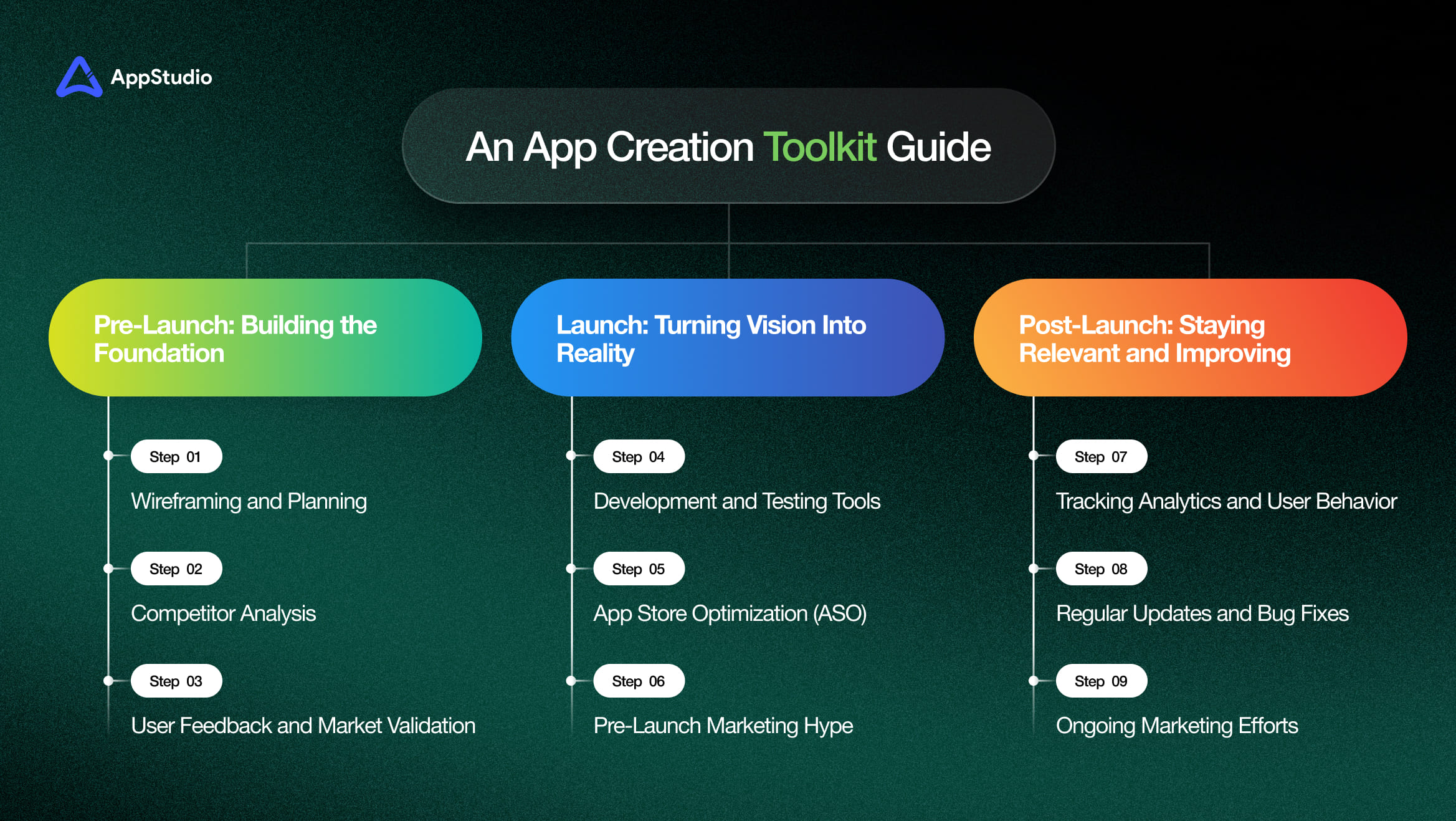
Building an app and setting up an app development step by step process takes more than just a great idea. It’s about how you prepare, execute, and sustain. Each phase demands specific resources, strategies, and mindsets to keep your app competitive and engaging. Let’s break it down so you can focus on maximizing every stage of the steps of application development process.
1. Pre-Launch: Building the Foundation
This is where your app starts to take shape—not in code, but in strategy. Before any development begins, you need clarity and research to ensure you’re creating something people actually want. Here’s how to go about it:
Step 1: Wireframing and Planning
Use tools like Figma or Sketch to create wireframes that visually map out your app’s layout and user flow. These are essential steps in creating an application to align your vision with the team and help spot flaws before they cost time and money during development.
Step 2: Competitor Analysis
Platforms like SimilarWeb and App Annie help you dissect competitors’ apps to understand what they’re doing right—and where they fall short. Focus on identifying gaps your app can fill or features you can improve upon. This will guide your application development steps strategically.
Step 3: User Feedback and Market Validation
Engage directly with your potential audience through surveys, polls, and forums like Reddit or Quora. Tools like Typeform or Google Forms are invaluable for gathering insights into user needs and expectations.
Testing your ideas with communities on Instagram, LinkedIn, or Facebook can refine your steps involved in app development and provide honest feedback to help validate your market.
2. Launch: Turning Vision Into Reality
Your pre-launch efforts set the stage, but the launch is where things start to move. Every resource at this phase should focus on smooth execution and visibility. Here’s the breakdown:
Step 4: Development and Testing Tools
Use development environments like Xcode (for iOS) and Android Studio (for Android) to start building your app. Employ Firebase for backend support and real-time databases, ensuring scalability from day one. Testing tools like TestFlight (iOS) and Firebase App Distribution (Android) help validate every aspect of your application development process steps with real-world feedback.
Step 5: App Store Optimization (ASO)
Your app’s discoverability on app stores can make or break your launch. Use tools like Sensor Tower or Mobile Action to research keywords and optimize your descriptions. Focus on compelling visuals—icons, screenshots, and preview videos that align with your steps to create an app and attract potential users.
Step 6: Pre-Launch Marketing Hype
Build buzz through social media campaigns, teasers, and email newsletters. Platforms like Hootsuite or Buffer help manage consistent posting schedules, while tools like Canva assist in creating attention-grabbing visuals.
Don’t just post—engage. Go live on Instagram, reply to comments, and DM your audience to establish authentic connections. These are critical steps for building an app audience before launch.
3. Post-Launch: Staying Relevant and Improving
Here’s where many apps lose momentum. Post-launch isn’t the end; it’s the beginning of long-term growth and engagement. This phase is all about using data to evolve and keep users hooked.
Step 7: Tracking Analytics and User Behavior
Tools like Google Analytics for Firebase, Mixpanel, and App Annie help you monitor user behavior, retention rates, and conversion paths. Use these insights to identify pain points, optimize user experiences, and refine features—core aspects of the steps to develop an app.
Step 8: Regular Updates and Bug Fixes
Updates aren’t optional—they’re expected. Regular fixes and feature rollouts keep users engaged and enhance the app experience. Use Jira or Trello for task management and tracking update cycles to ensure efficient execution of these steps of app development.
Step 9: Ongoing Marketing Efforts
Post-launch marketing is critical for sustained visibility. Use push notifications to re-engage users and email campaigns to announce updates or promotions. Social media doesn’t stop after launch—create user-generated content opportunities or share success stories to maintain momentum throughout the steps of application development.
Moral: App Creation is not a Single Event. It is a Journey.
- The pre-launch stage is where your vision solidifies.
- The launch is where your execution shines.
- The post-launch phase is where you ensure your app remains relevant.
Stay focused, stay adaptable, and keep refining. Whether you’re a startup founder or an established business, this framework on will guide you through the step by step app development process and help you create an app—users will love.
Related reading: How Long Does it Take to Develop an App?
Wrapping Up!
How to develop an app is an often searched term on the internet. And why lie, creating an app may seem overwhelming at first, but as we’ve explored, it’s simply about following a clear, step by step app development approach. From refining your idea and understanding your audience to sketching wireframes and testing rigorously, every stage builds on the last to create a product that truly resonates with users.
By focusing on solving real problems and offering unique value, your app can stand out in a crowded market and attract loyal users.
Remember, an app’s success doesn’t end at launch. Maintenance, updates, UI/UX, interface, and marketing are just as important to keep users engaged and coming back for more. Whether you’re starting from scratch or refining an existing idea, these steps involved in app development will help you confidently navigate the process with ease.If you’re someone looking to bring your business’s application vision to life, Appstudio is here to help you every step of the way on your exclusive success journey to “how to develop an app” that performs, generates revenues and brings back your customers for more. Schedule a FREE Consultation Call today and let such worries be woes of the past. Build an application that’s as functional, beautiful, and extraordinary as your imagination.
Frequently Asked Questions
The first step of how to build an app is defining your application’s purpose. This involves identifying the specific problem your app will solve and understanding why users will need it. A clear purpose is the foundation for every decision you make during the development process, from features to marketing strategies.
Not necessarily. No-code platforms like Bubble or Adalo allow you to build basic apps without coding knowledge. For more complex apps, hiring a professional developer or partnering with an agency like Appstudio is a good option. It’s important to focus on your strengths, whether that’s conceptualizing the app or managing its business aspects, while leaving technical work to experts if needed.
The development timeline depends on the app’s complexity, features, and platforms. A simple app can take 2–3 months, while a feature-rich app could take 6 months or more. Keep in mind that the timeline also includes research, design, testing, and refinement stages, which are essential for a high-quality product.
Common tools for app development step by step process include design platforms like Figma or Adobe XD for wireframes, development environments like Android Studio or Xcode for coding, and Git for version control. You’ll also need testing tools like Firebase or BrowserStack. Choosing the right tools ensures smoother development and saves time.
The cost varies based on features, platforms (iOS, Android, or both), and whether you’re using no-code solutions or custom development. A basic app might cost $5,000–$20,000, while a fully-featured app can exceed $100,000. Consider long-term expenses like updates and marketing when budgeting.
Your app needs a unique value proposition—something that sets it apart from competitors. While figuring out how to develop an app it’s important to focus on user-friendly design, solving a specific pain point, and delivering consistent value. Strong branding, an intuitive interface, and responsive customer support also play key roles in standing out.
This depends on your target audience. If your users are primarily iPhone users, focus on iOS; for broader global reach, Android is often better. Cross-platform development with tools like Flutter or React Native can help you cover both platforms efficiently and save on development costs.
Testing involves multiple stages: unit testing for individual components, integration testing to check if features work together, and beta testing with real users. Tools like TestFlight (for iOS) or Firebase Test Lab (for Android) can simplify the process. Thorough testing helps identify bugs and ensures your app performs well under real-world conditions.
Start with app store optimization (ASO) by using the right keywords, visuals, and descriptions to improve visibility. Leverage social media platforms, content marketing, and email campaigns to create buzz. Partnering with influencers or offering referral bonuses can also help increase downloads and user engagement.
Post-launch activities include monitoring user feedback through app store reviews, analytics, or in-app feedback tools. Regular updates to fix bugs, enhance features, and stay compatible with new technologies are crucial. Engaging with users through notifications, loyalty programs, or new content keeps them coming back.
